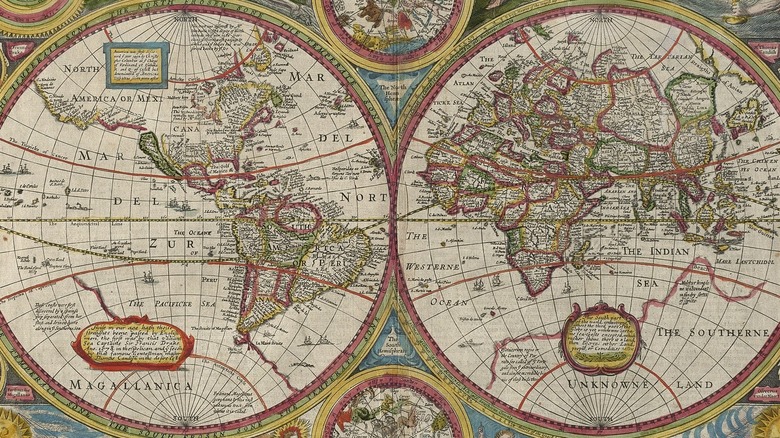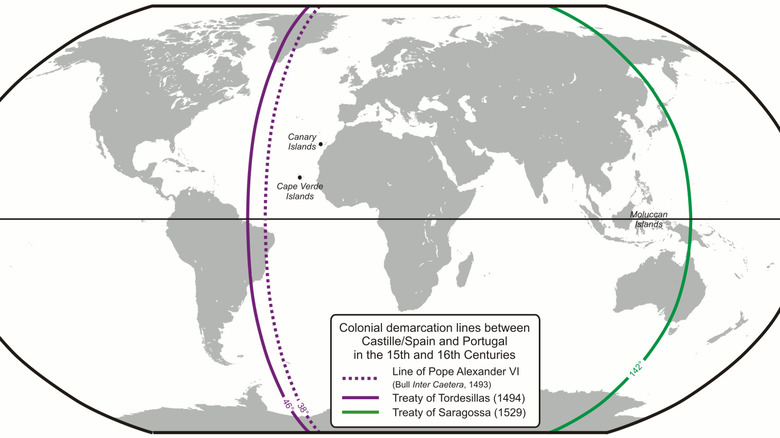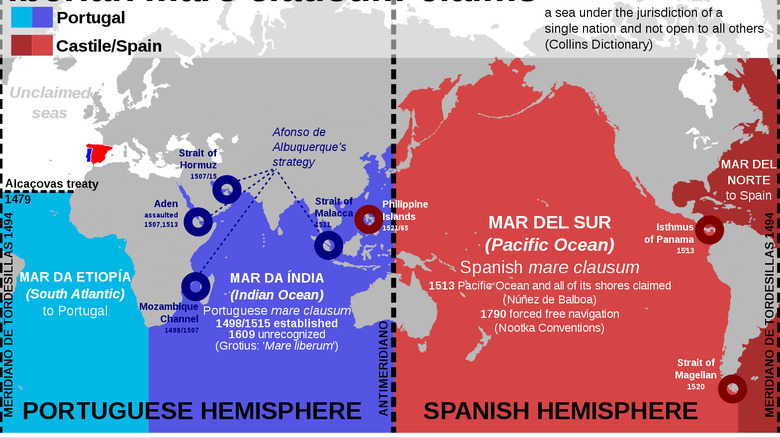Here's Why The Pope Once Split The World In Two
The story begins with a line you probably remember from grade school: "In 1492, Columbus sailed the ocean blue." But you probably didn't learn that, when Christopher Columbus returned to Europe from his Spain-funded voyage to the "Indies," his first stop was in Lisbon, Portugal — not Spain. In Lisbon, Columbus requested an audience with King John II of Portugal, a man who, about a decade earlier, had refused to finance Columbus' mission of exploration. Per Encyclopedia Britannica, Columbus related that he had discovered new islands in the southwest Atlantic Ocean, and that he had claimed these on behalf of Spain.
The news angered King John II, who soon wrote a vehement letter to the Spanish royalty. In that letter, the King accused Spain of violating the 1479 Treaty of Alcaçovas. Per Tordesillas, that treaty stipulated that Spain would gain control of the Canary Islands, an archipelago in the Atlantic Ocean to the east of Morocco, whereas the land and waters of the Atlantic to the south of the Canary Islands would belong to Portugal. Invoking the Treaty of Alcaçovas, King John II argued that any new lands discovered by Christopher Columbus rightfully belonged to Portugal. The king also suggested that he was willing to use military force to back up his new claims. At the time, Spain's naval presence in the Atlantic was lacking, and so the Spanish crown sought a diplomatic, rather than a military. solution to the dispute.
With the 1494 Treaty of Tordesillas, Pope Julius II approved a plan to divide the world
The first attempted solution to the Spanish-Portuguese territorial dispute was a line drawn by Pope Alexander VI, but Portugal quickly dismissed the plan as being too favorable to Spain. (Pope Alexander VI was Spanish by birth, after all.) Instead, the rulers of Spain and Portugal took negotiations into their own hands; per Encyclopedia Britannica, a 1494 meeting between Spanish and Portuguese diplomats resulted in the now-famous Treaty of Tordesillas, named for the Spanish city in which it was created. This treaty established a vertical line 370 leagues west of the Cape Verde islands; all territory to the east of the line would belong to Portugal, while all lands to the west could be claimed by Spain.
This treaty is often remembered as the papal plan to split the world, but, in reality, then-Pope Alexander VI had essentially no role in its creation. It was not until a decade later that the subsequent Pope — Julius II, an Italian — gave the Treaty of Tordesillas his stamp of approval. Even so, most European nations outside of Spain and Portugal chose to ignore the treaty altogether.
If you've ever seen a map of the world that the Treaty of Tordesillas created, you may find that it looks quite unfair to Portugal; over 90% of the New World falls on Spain's side, with just a small sliver of eastern South America going to Portugal.
The Treaty of Tordesillas split the world between Spanish and Portuguese control
However, there are a few things to keep in mind about the Treaty of Tordesillas. First, as National Geographic notes, the treaty was written at a time when Europeans still had no idea what the New World really looked like. By 1494, Columbus had only made two expeditions to the Caribbean, and he was still convinced that the islands were somehow part of Asia.
Second, Portugal's reason for supporting the Treaty of Tordesillas was not due to its territorial gains in the New World, but rather in the Old World. While the Treaty gave Spain control over most of the Americas, Portugal in turn got to claim new lands in Africa. Further, as Princeton writes, when both Spain and Portugal began to expand into Asia in the early 1500s, the 1529 Treaty of Zaragoza confirmed that the line drawn by the Treaty of Tordesillas wrapped all the way around the world. Thus, the Earth was divided into a hemisphere of Spanish control and a hemisphere of Portuguese control, as the map above demonstrates.
Of course, as time goes on, treaties fade and are replaced. When Portugal did begin to colonize the New World, it found the Treaty of Tordesillas far too restrictive, and expanded west of the line. The Treaty of Madrid (via Encyclopedia) confirmed that Portugal could colonize the Amazon river basin. That's why Brazil, Portugal's former colony, extends well past the line designated by the 1494 Treaty of Tordesillas.


